La Goulue | |
|---|---|
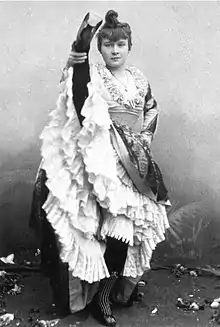 | |
| Born | Louise Weber 12 July 1866 Clichy, Hauts-de-Seine, France |
| Died | 29 January 1929 (aged 62) Paris, France |
| Resting place | Cimitière de Montmartre 48°53′16″N 2°19′49″E / 48.88778°N 2.33028°E |
| Other names | The Queen of Montmartre |
| Occupation | Dancer |
| Years active | 1882–1928 |
| Employer | Moulin Rouge |
La Goulue (French pronunciation: [la guly], meaning The Glutton), was the stage name of Louise Weber (12 July 1866 – 29 January 1929), a French can-can dancer who was a star of the Moulin Rouge, a popular cabaret in the Pigalle district of Paris, near Montmartre.[1] Weber became known as La Goulue because as an adolescent, she was known for guzzling cabaret patrons' drinks while dancing.[2] She also was referred to as the Queen of Montmartre.[3]
Childhood
Very little is known about her early childhood, but it is believed that Louise Weber was born into a Jewish family from Alsace that eventually moved to Clichy, Hauts-de-Seine, near Paris. Her mother worked in a laundry. As an impoverished young girl who loved to dance, Weber is said to have enjoyed dressing up in laundry customers' expensive clothing and pretending to be a glamorous star on a great stage. At age 16, she was working with her mother in the laundry, but behind her mother's back began sneaking off to a dance hall dressed in a customer's "borrowed" dress.[4]
Early career

Dancing at small clubs around Paris, Weber quickly became a popular personality, liked for both her dancing skills and her charming, audacious behavior. In her routine, she would tease the male audience by swirling her raised dress to reveal the heart embroidered on her knickers and would do a high kick while flipping off a man's hat with her toe.[5] Because of her frequent habit of picking up a customer's glass and quickly downing its contents while dancing past his table, she was affectionately nicknamed La Goulue (The Glutton).[6] Eventually she met the Montmartre painter Pierre-Auguste Renoir, who introduced her to a group of models who earned extra money posing for the community's artists and photographers. Achille Delmaet, husband of Marie Juliette Louvet, would later find fame as the photographer who had taken many nude photographs of La Goulue.[7]

Star of the Moulin Rouge
Louise Weber was taken under the wing of Jacques Renaudin (1843–1907), a wine merchant who danced in his spare time under the stage name Valentin le Désossé.[9] They danced at the renowned Moulin Rouge in Montmartre when it first opened, performing an early form of the cancan known as the chahut.[10] The two were instant stars, but it was Weber who stole the show with her outrageously captivating conduct. Booked as a permanent headliner, La Goulue became synonymous with the can-can and the Moulin Rouge nightclub.[11] The toast of Paris and the highest paid entertainer of her day, she became one of the favorite subjects for Henri de Toulouse-Lautrec, immortalized by his portraits and posters of her dancing at the Moulin Rouge.[12] Her best friend was La Môme Fromage (The Cheesy Girl), another famous cancan dancer at the Moulin Rouge. They were so close that people called them sisters. [13]
Decline
Having achieved both fame and fortune, Weber decided to part company with the Moulin Rouge in 1895 and strike out on her own.[14] She invested a considerable amount of money into a show that travelled the country as part of a large fair; but her fans who had lined up to buy tickets at the Moulin Rouge did not take to the new setting, and her business venture turned into a dismal failure. Following the closure of her show, La Goulue disappeared from the public eye. Suffering from depression, she drank heavily and dissipated the small fortune she had accrued while dancing.[15][16][17]
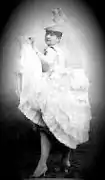
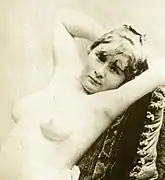 1885
1885
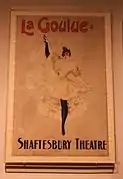 1894
1894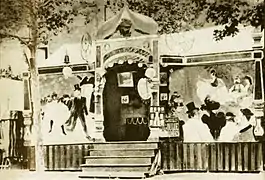 1895 show
1895 show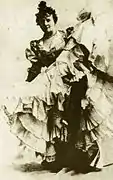
Alcoholic and destitute, La Goulue returned to Montmartre in 1928.[18] She eked out a living selling peanuts, cigarettes, and matches on a street corner near the Moulin Rouge; few recognized the severely overweight and haggard former Queen of Montmartre. She died a year later at age 62 in the 10th arrondissement of Paris and was buried in the Cimetière de Pantin in the Paris suburb of Pantin, but later her remains were transferred to the Cimetière de Montmartre.[19][20]

Cultural references
- 1889/90. Painting. Georges Seurat. Le Chahut. Oil on canvas. Kröller-Müller Museum, Otterlo, Netherlands.
- 1891. Poster. Henri de Toulouse-Lautrec. Moulin Rouge: La Goulue. Color lithograph. Approximate print run: 3,000 copies.
- 1934. Ballet. Bar aux Folies-Bergère. Choreography by Ninette de Valois. Music by Emmanuel Chabrier. Created for Ballet Rambert, London, with Alicia Markova as La Goulue and Frederick Ashton as Valentin le Désossé.[21]
- 1950. Novel. Pierre La Mure. Moulin Rouge. Based on the life of Henri de Toulouse-Lautrec. New York Random House.
- 1952. Film. Moulin Rouge. Directed by John Huston. Romulus Films. A biography of Henri de Toulouse-Lautrec, with Katherine Kath as La Goulue and Walter Crisham as Valentin le Désossé.
- 1955. Film. French Cancan. A fictionalized history of the Moulin Rouge, written and directed by Jean Renoir and starring Jean Gabin. Franco London Films. With Françoise Arnoul as La Goulue and Philippe Clay as Valentin le Désossé, called Nini and Casimir le Serpentin in the film.
See also
References
- ↑ Philippe Le Moal, ed., "La Goulue", in Dictionnaire de la Danse (Paris: Éditions Larousse, 1999).
- ↑ Moulin Rouge (Site Officiel). "La Goulue". moulinrouge.fr. Retrieved 6 August 2018.
- ↑ Maximillien de Lafayette, The Rise and Fall of La Goulue, part 1, Louise Weber, Queen of the Parisian Cabarets, 2nd ed. (New York: Times Square Books, 2011).
- ↑ Michel Souvais, Moi, La Goulue de Toulouse-Lautrec: Mémoires de Mon Aïeule (Paris: Publibook, 2008).
- ↑ Lucinda Jarrett, Stripping in Time: A History of Erotic Dancing (San Francisco: Harper Collins, 1997).
- ↑ Walter Sorrell, "The Dancers of Toulouse-Lautrec", Dance Magazine (New York), October 1953, pp. 28–29, 66–67.
- ↑ David Price, Cancan! (London: Cygnus Books, 2011).
- ↑ "Henri de Toulouse-Lautrec. La Goulue at the Moulin Rouge. (1891–92) – MoMA". www.moma.org. Retrieved 6 August 2018.
- ↑ Philippe Le Moal, ed., "Valentin le Désossé", in Dictionnaire de la Danse (Paris: Éditions Larousse, 1999).
- ↑ Francis Henry Gribble, "The Origin of the Can-Can" (April 1933), reprinted in Dancing Times (London), October 1990, pp. 53–54.
- ↑ Jacqeus Pessis and Jacques Crépineau, The Moulin Rouge (New York: St. Martin's Press, 1990).
- ↑ Henri de la Toulouse-Lautrec and Federico Zeri, Toulouse-Lautrec: At the Moulin Rouge, One Hundred Paintings Series (London: Nde Publishers, 2000).
- ↑ David Sweetman, Explosive Acts: Toulouse-Lautrec, Oscar Wilde, Félix Fénéon and the Art & Anarchy of the Fin de Siècle (New York: Simon & Schuster, 1999).
- ↑ Robert Rey, "La Goulue", in Les Femmes Célébres (Paris, 1959)
- ↑ Michel Souvais, Moi, La Goulue de Toulouse-Lautrec (2008).
- ↑ "ODE to a Fallen Queen". POOR LITTLE RICH GIRL By Boudoir Queen. Archived from the original on 6 August 2018. Retrieved 6 August 2018.
- ↑ "Meet the Fallen Queen of the Moulin Rouge". www.messynessychic.com. 7 May 2018. Retrieved 6 August 2018.
- ↑ "LEGACY OF LOUISE WEBER". americanhospitalityinstitute.org. Archived from the original on 6 August 2018. Retrieved 6 August 2018.
- ↑ Cemetières de France et d'Ailleurs: Biographie et Photos, online: www.landrucimitères.fr.
- ↑ "La Goulue". wordpress.com. 15 September 2014. Retrieved 6 August 2018.
- ↑ Beth Genné, The Making of a Choreographer: Ninette de Valois and Bar aux Folies-Bergère. Studies in Dance History (Society of Dance History Scholars, 1996).
External links
- Louise Weber at Find A Grave
- Video biography—This might be the most diligently researched biography about her in parallel to the history of Moulin Rouge and the Can-can. Includes a few short filmstrips of her.
- JOSY ANDRIEU "LA GOULUE"—A most likely inaccurate French song of La Goulue.
- La Goulue by Henri de Toulouse-Lautrec | Check123 - Video Encyclopedia